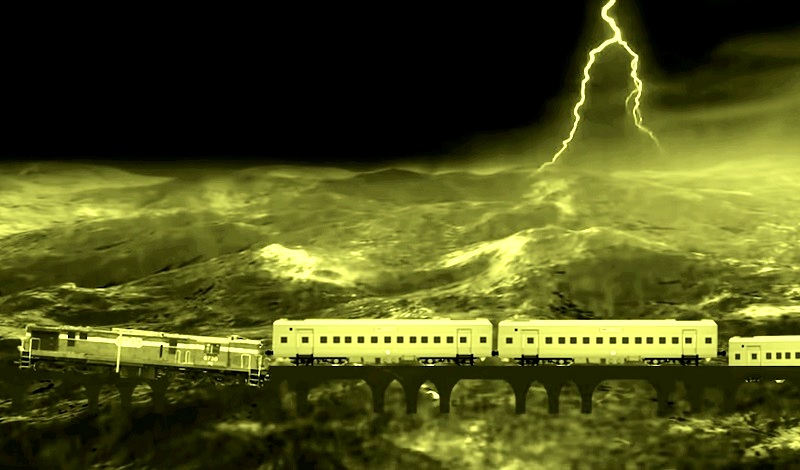Pamban Bridge is such a name that people who get to know it gets excited by its imagination only. If you don't know, let's tell you that the Pamban railway bridge connects the town of Rameswaram on Pamban Island to mainland India. The length of this bridge is 2.065 km and it is built in the middle of the sea. Although many accidents happen in the railways, we sometimes get to hear about it, but what if there happens an accident when the entire train gets swept away in the water, it would be very strange to hear. But all this happened due to a deadly cyclone, named 1964 Rameswaram cyclone or Dhanushkodi cyclone that destroyed the entire Dhanushkodi. Let us tell you that an estimated 1,800 people were killed in the cyclonic storm and the town remains uninhabited after this devastating event and the government declared the entire town as a ghost town, which was unfit for living.
Image By Shaswat Nimesh
Due to the darkness around and the signaling system being shut down, the "Loco pilot" had to stop the train behind the railway station. After a long time of waiting, the "loco pilot" thought of taking the risk when no signal was found and without any signal, he drove the train ahead. But at that time the tidal waves were very high around 23 ft and then such a wave came at once that the entire six coach train was swept away in just a single second, including 115 people traveling by the Pamban-Dhanushkodi passenger train that night. Several figures also suggest that some passengers who were without tickets may have a much larger number. Many believe that a total of 180 to 200 passengers were swept away in the storm along with the train. For hours thereafter the storm continued to show its wrath, and during that time more than 1000 people lost their lives in Dhanushkodi alone. It is said that this storm was one of the most powerful storms to ever strike India on record, you can still see the signs of its destruction in Dhanushkodi. By 1964, Dhanushkodi, which was one of the major entry points to visit India, was completely ruined after this accident. The damaged rail tracks, station, and houses all remind us of the same story that in reality, it was a very terrifying natural disaster. Pamban Bridge was largely destroyed in that disaster.
Image By Shaswat Nimesh
Devastating Train Accident
On December 15, 1964, India identified the low-pressure area being emerging over the Andaman Sea, which meant that rain and storm were just about to knock on the door. Everything seemed to be normal, till then no one was aware that the wind running at a speed of 45 km per hour is going to take the shape of a terrible storm soon. On 21 December, the storm started moving towards the west with more strength than anticipated, and satellite imagery of that time was also taken in which it was clearly showed clouds from the storm that covered an area of approximately 965 km wide. On 22 December, the storm, with a speed of about 110 km per hour, struck the northern tip of Ceylon i.e. now called Sri Lanka. After hitting, the storm started moving towards west-northwest, and after that its speed reached about 280 km/h. Now it was the evening of 22 December and in the evening Mr. Sunderaraj, who was the station master of Danushkodi Railway Station, had reached home after finishing his duty. Around 9 o'clock in the night, the weather became very bad due to the strong winds and water started entering people's homes, no one knew what was happening. Meanwhile, just a short distance from Dhanushkodi railway station, Train No.653, Pamban-Dhanushkodi Passenger (a meter gauge train), which was a daily train that carried people from Pamban to Dhanushkodi and people traveled from there to Sri Lanka on the ferry. It must have been around 23:55 that night, the train had gone far ahead of Pamban station and was about to reach Dhanushkodi railway station when the speed of the storm suddenly increased.Due to the darkness around and the signaling system being shut down, the "Loco pilot" had to stop the train behind the railway station. After a long time of waiting, the "loco pilot" thought of taking the risk when no signal was found and without any signal, he drove the train ahead. But at that time the tidal waves were very high around 23 ft and then such a wave came at once that the entire six coach train was swept away in just a single second, including 115 people traveling by the Pamban-Dhanushkodi passenger train that night. Several figures also suggest that some passengers who were without tickets may have a much larger number. Many believe that a total of 180 to 200 passengers were swept away in the storm along with the train. For hours thereafter the storm continued to show its wrath, and during that time more than 1000 people lost their lives in Dhanushkodi alone. It is said that this storm was one of the most powerful storms to ever strike India on record, you can still see the signs of its destruction in Dhanushkodi. By 1964, Dhanushkodi, which was one of the major entry points to visit India, was completely ruined after this accident. The damaged rail tracks, station, and houses all remind us of the same story that in reality, it was a very terrifying natural disaster. Pamban Bridge was largely destroyed in that disaster.















0 comments:
Post a Comment